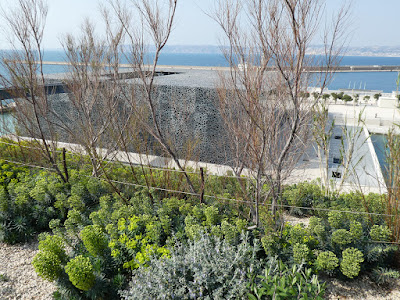The new building seen from Fort Saint-Jean
MuCEM from the Jardin du Pharo
Fort Saint-Jean from the new MuCEM building
There are walkways like this on every level.
MuCEM in March, 2017
MuCEM (Musée des Civilisations de l'Europe et de la Méditerranée) is a museum in Marseille, France. It is the first museum in the world devoted to Mediterranean cultures. An architectural contest began in October 2002, organized by the Ministry of Culture and of Communication, with 6 teams of architects competing. Rudy Ricciotti was selected in February 2004. MuCEM was inaugurated in 2013, the year Marseille was the European Capital of Culture. About half of the new building is covered by a lacy construction of fiber-concrete meant to resemble fishnet, the most visually interesting part of the design. This covering is called the mantilla, a lace headscarf worn in Spain. There are walkways on every level between the mantilla & the glass walls. The building is set on a pier just outside the Vieux (Old) Port & connected by a footbridge to the remodeled Fort Saint-Jean, also part of the museum. Rudy Ricciotti was born in 1952 in Algeria. He studied architecture at the National School of Architecture in Marseille & then engineering at the School of Engineering of Geneva. In 2006, he received the Grand Prix national de l'architecture, a French prize awarded by a jury of twenty persons (under the Ministry of Culture) for recognition of outstanding contribution to architecture.











































































